Caught a monster bass on Lake Francis a couple weekends ago. Met a guy who loves to fish and we’ve been getting out as much as possible. Check out this lovely thing. I’m thinking it’s around 7lbs. Hard to say, since we didn’t measure it.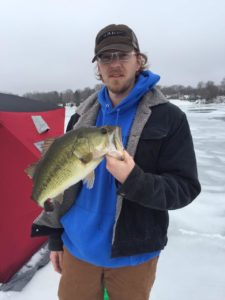
Ice Fishing
Over the last couple weeks I’ve purchased all the ice fishing gear I will need to catch fish over the ice, aka hard water. I got a nordic legend auger/ice house combo from menards. Highly recommend this for the budget conscious person. It was vastly cheaper than anything out there, and it seems to perform just fine.
Today I met a new fishing friend, we will call him D. Hopefully a long future of fishing is together for us. We seem to have many overlapping hobbies.
I’ve been trying to find the fish all week, but haven’t had much luck. Read fishing reports and got out there and just tried stuff. Today changed that though, I was fishing the west end of Lake Francis, which is east of Madison Lake (east of Mankato). The GPS coordinates for approximate location are 44.210378, -93.723875. I set down a point on the Striker as FRA2.
Fished with pink sparkle top, yellow dot small jig, and a glowing yellow, with orange dot jig. The first being the most successful, and the later working better once the sun started getting lower on the horizon.
Caught about 30 bluegill, a couple small pumpkinseeds, and a small pike.
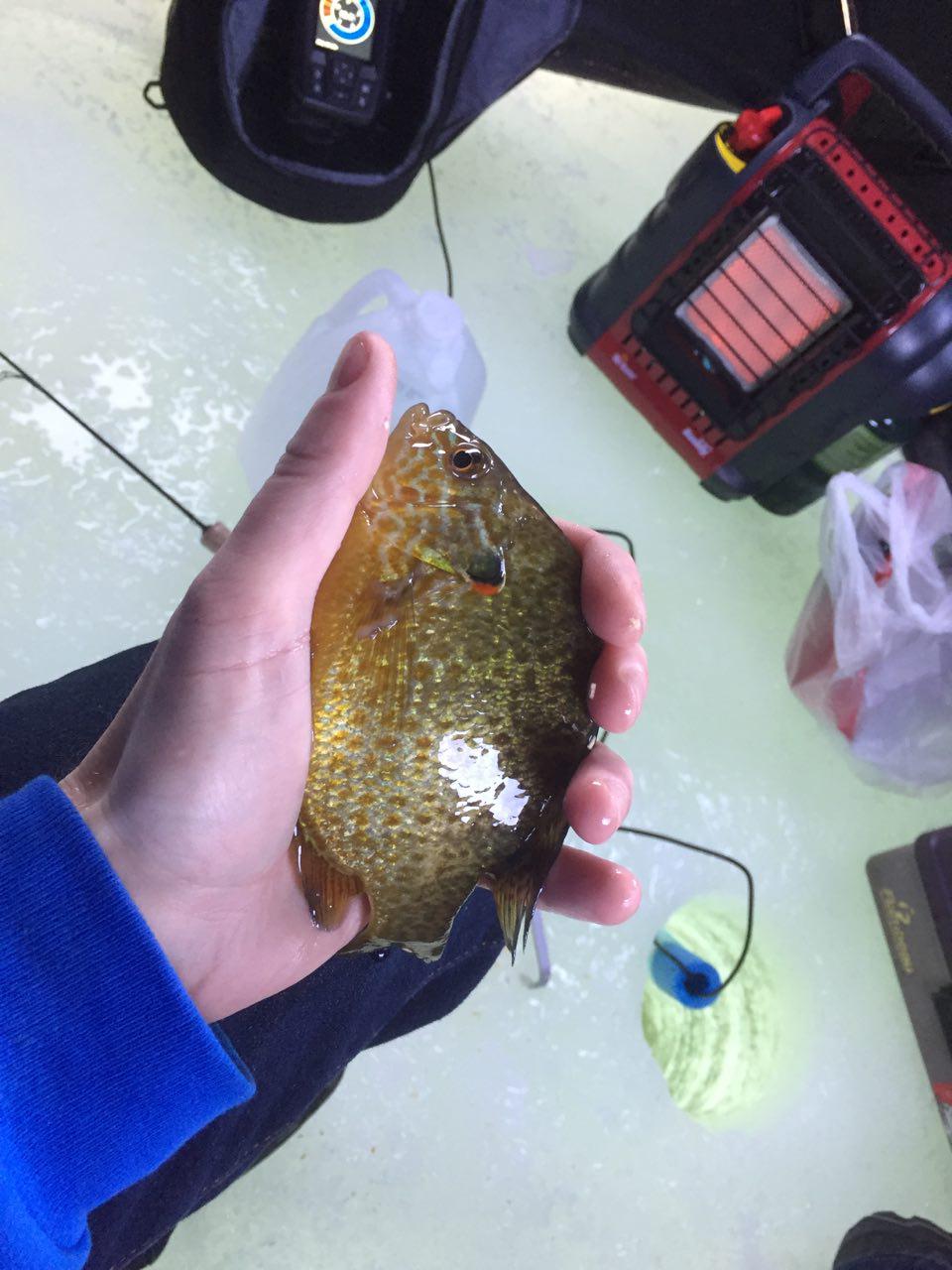
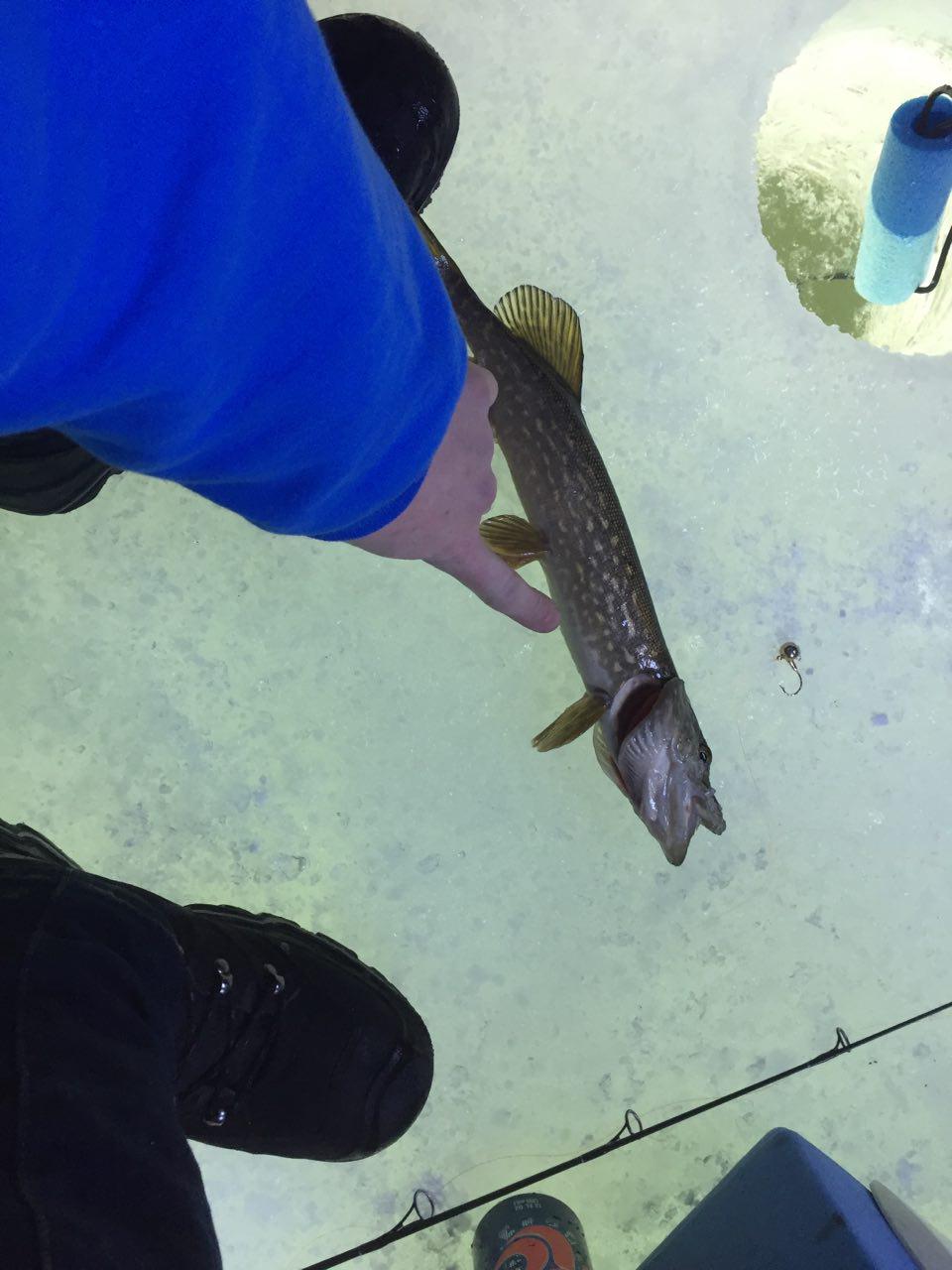
First Week of Work Done
I got a job with Mankato Clinic in Mankato. I’m working for a month under a contract with a laboratory staffing agency. Then I’ll be full time. I’ve gotten through the first week of work, and I really feel I’ll like working there. Hopefully I can learn everything next week so my coworker (I only have one) can get time off if she needs it.
Since it’s such a nasty commute, I’m looking at getting a commuter car that gets 50mpg. This should help mitigate the cost of having to drive so far. I don’t mind the drive at all, but I’ll be paying a lot of money per month to drive my wagon.
So, everything is going well. I’m still adjusting to the schedule, but it’s really reasonable. I’m so glad I was finally able to find some work 🙂
Job Recruiters
I’ve had a recent in surge of recruiters calling me based on my careerbuilder.com and indeed.com profiles. I’ve put a large amount of effort into making those and my linkedin profiles strong and it’s nice to see those paying off.
I’ve not had much luck directly applying for positions posted on job boards, so it’s very nice that I’m finally making some traction building my online brand. Hopefully some job offers start coming in and I can meet with some companies here in Minnesota to find the perfect fit.
As soon as a job happens, I’ll be able to use my savings and finally start the search for a house to buy. I’ve been renting up until this point in my life and I would really like to start building equity.
Things are looking up, I’m feeling confident, and I can’t wait to see what opportunities lie in wait for me. Thank you everyone who has contacted me, and I hope this website will help you gain an understanding of what I’m like.
Don’t forget to visit my skills and techniques page, and please contact me at eric@ericjohnhanson.com or visit the contact me page to get a hold of me. Thanks for visiting!
Continuing Work on This Site
I continue to back date skills posts to flesh out my skills list. Writing up those posts has me going through a more than 10,000+ photo folder to find pictures I’ve taken that are relevant to the posts. It’s so much work. I’ve already put 40 hours into just adding content to the site. It’s daunting work, and I really and hoping that it pays off in the end.
Some things I’m going to work on once all the skill posts are fleshed out is, reading and reviewing scientific articles. I also am going to start getting involved in the international and organized animal groups out there that bring together professionals and enthusiasts. Going to mainly focus on groups dealing with behavior, ecology, conservation, entomology, and research. Hopefully I can gain some contacts within there and network to a better job. I’ve tried the online job boards, but those just seem to not work at all. I get zero communication, and I’m starting to doubt it’s because I’m writing poor cover letters or not having a fleshed out resume.
Also once this site is done to the point where I’m just adding new content, I can get it up on all the job search sites. I’ve had some luck with recruiters contacting me over Indeed, Career Builder, and Linked In, but the problem is, most of them are wanting me for a travelling histology position. That would be great, if I were not married and didn’t have local responsibilities. I may end up having to take one just to pay the bills, but hopefully something local works out for us.
AeroTek Recruiter
Good news, I have a meet and greet with an Aerotek representative tomorrow. They are an excellent technical and scientific placement service. I look forward to working with them. My husband is also using their service. Here’s to hoping for a good placement!
Film Development
Film developing costs can be pretty expensive when you are sending the film rolls to a lab. To cut down on those costs and to have some chemistry fun at home, I took on developing my own black and white film. Color film isn’t terrible hard to do at home either, but the chemistry is a little less ecofriendly. The steps are much more cookie cutter, and everything has to maintain a certain temperature.
So instead, I use Paterson Super System 4 developing tanks and plastic reels. I load the film in a changing bag in a room without windows with a towel stuffed under the door. So far that has yielded pretty good results and I’m a pro at winding 35mm and 120 roll film onto the reels without seeing what’s going on elbow deep in a changing bag.
My go to developer is Kodak HC-110 because it doesn’t go bad very quickly, and I don’t develop film weekly or even monthly. I usually wait until I have several rolls ready and then do them all at once.
The amount of time the film sits in each chemical is determined by what type of film it is and the ISO (light sensitivity) number. There’s a sheet called the massive developers chart that I use. For timers I use my smart phone or tablet. If you are interested in learning how to develop your own film, I would love to teach you.
For drying the film, I’ve found a photoflo solution helps with water spots, and also hanging the film at a bit of an angle. The angle is important because all the water flows to the edge of the film and spots up there instead of right in the middle of the negative. Someday I will have a nice air filtrated drying chamber, but for now I use a cheap method to create a clean room. I just run the shower on hot for a few minutes until the whole room is steamy then turn on the bathroom fan and once it’s not humid in there anymore I bring the film in and set it up to dry. It really helps with dust on the negatives.
Once the negatives are all dry, I’ll cut them up, put them in plastic sleeves, and get out my film scanner and clean it up really good with compressed air and anti-static spray. Then the negatives are scanned in strips, and I edit using Adobe Photoshop and Lightroom.
Film Photography
Please check out my Film Photography Portfolio, or continue reading about my history with film photography.
My story with photography continues where my history with digital photography left off.
When my time at Zzyzx, CA – Desert Studies Center – was over, I decided to continue to journey through life instead of returning back home to North Dakota. I ended up meeting up with a long time internet friend of mine in Pahrump, NV and moved in with his friend and him. I ended up building a giant steel building in Snowflake, AZ with these guys, but also met a guy named Bart Cohen.
Bart introduced me to film photography. We would spend many hours talking over a bottle of Sailor Jerry rum and reminisce. He taught me a lot of things about photography and allowed me to pick his brain. He gave me a Zeiss Ikonta C to get me started. It shot a giant 6x9cm negative. Since I already had a pretty good 8MP digital camera, I wasn’t super interested in shooting 35mm film. The Zeiss shot medium format 120 roll film.
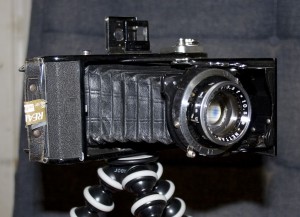
The bug was set. I’ve never had much disposable income, so I can getsuper amazing shots on B&W film using the top of the line lenses from history. The fully mechanical cameras are my absolute favorite.
After I lugged and shot many rolls of film through the Ikonta, I realized there were many leaks in the bellows of the old thing. So I had to start upgrading. Bellows are hard to come by, and the companies that used to make them are mostly out of business. I ended up getting another Zeiss Camera, a TLR called the Ikoflex. TLR stands for twin lens reflex, it actually uses two lenses, but only one to take the actual picture. The top lens is diverted through a mirror onto a lens that you look down onto from the top.
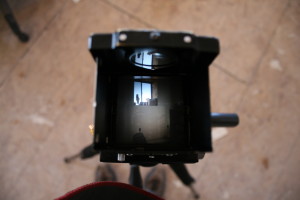
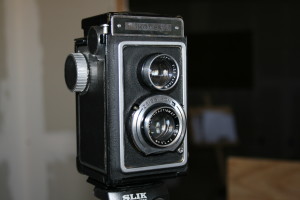
I’ve also gotten a bunch more cameras throughout the years, and even joined a few clubs and got other people interested in film. Film is still accessible today and hasn’t been completely outpaced by digital cameras, yet. The medium and large format films can easily shoot images with higher dynamic range and offer tighter and clearer pictures because they can be scanned at an equivalent of 50-100MP+ depending on the size of the negative.
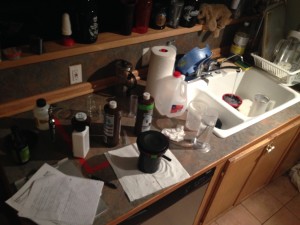

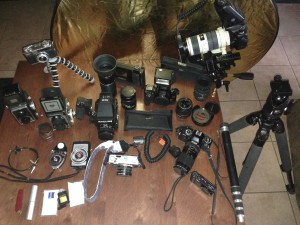
Digital Photography
See my Digital Photography Portfolio, or continue on reading about my history with digital cameras.
I began using cameras when I was in the Boy Scouts. My parents got me a nice automatic 35mm camera. I shot many many rolls through that during the times I went camping, especially in Glacier National Park. Then junior high school became more of a thing in my life and I ended up having less time to and interest in photography.
Then I began getting into website development and my father got me a Kodak DC120 digital camera. It was a massive camcorder looking still camera that took pictures at 1.2 MP. I did some neat web development and showcased my father’s business, the House of Color, and the work they were doing. The website has since been replaced with someone much more modern than something created in the late 90’s.
I took a ton of pictures with the 2MB CF cards I had for the Kodak, and used it up until I got into college. I was floating my roommates rent for him while he was waiting for his loan paperwork to clear. It took them many months, and when I was finally paid, I bought myself a new camera. I ended up getting the Olympus C-7070WZ. It was quite the leap in technology at 7.1MP over the Kodak’s 1.2MP. I used this camera to complete the Photographic Guide to Common Fishes of the Buffalo River.
During my capstone project I studied the behavior of the Green Darner dragonfly. While collecting data in the lab, I was presented with the opportunity to go to California to study an endangered fish. I ended up getting that opportunity, and worked in Zzyzx, CA at the Desert Studies Center for a summer with a student at North Dakota State University. About half way through that project, I had enough money saved up to get myself a better camera.
I ended up getting a Canon 30D, which was new that year, and the 70-200 f/4.0L Canon lens. This was an incredible leap in photographic technology. I spent a lot of time behind that camera. I still use it today, and a majority of the pictures on my portfolio were taken with this camera. Over the years I’ve gotten a couple other lenses for it including the 18-55 canon kit EFS lens, and the EF Sigma DX 50 macro lens.
First Post
This is the beginning. It started it all. I’ve registered the domain and intend to fill this with my personal information for prospective clients and employers. Let this serve as the first post on what will become a tremendous resource for getting to know who and what I am professionally.
Please sit back, put your feet up, and sip some coffee as you navigate through everything I’ve done to get to where I am today.
Thank you for visiting. Please visit my About Me and Contact pages and don’t hesitate to send in any questions.
